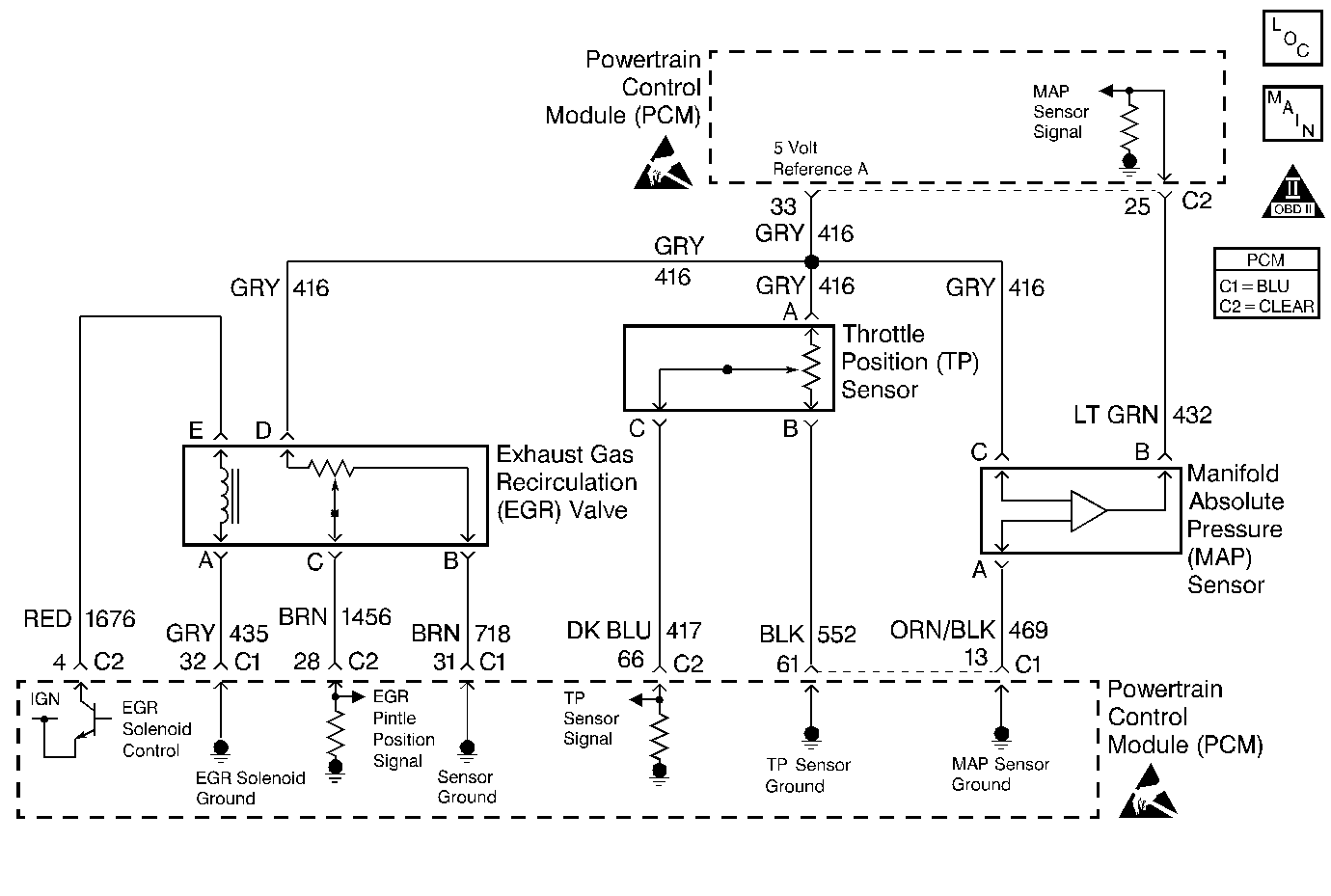
Circuit Description
The PCM uses the 5 Volt Reference A circuit as a sensor feed to the following sensors:
| • | The TP sensor. |
| • | The MAP sensor. |
| • | The EGR Valve Pintle Position sensor. |
The PCM monitors the voltage on the 5 Volt Reference A circuit. If the voltage is out of tolerance, the PCM will set DTC P1635.
Conditions for Setting the DTC
| • | The PCM detects a voltage out of tolerance condition on the 5 Volt Reference A circuit. |
| • | The above condition is present for longer than 10 seconds. |
Action Taken When the DTC Sets
| • | The PCM illuminates the malfunction indicator lamp (MIL) on the second consecutive ignition cycle that the diagnostic runs and fails. |
| • | The PCM records the operating conditions at the time the diagnostic fails. The first time the diagnostic fails, the PCM stores this information in the Failure Records. If the diagnostic reports a failure on the second consecutive ignition cycle, the PCM records the operating conditions at the time of the failure. The PCM writes the conditions to the Freeze Frame and updates the Failure Records. |
Conditions for Clearing the MIL/DTC
| • | The PCM turns the MIL Off after three consecutive drive trips that the diagnostic runs and does not fail. |
| • | A last test failed (current DTC) clears when the diagnostic runs and does not fail. |
| • | A History DTC clears after forty consecutive warm-up cycles, if this or any other emission related diagnostic does not report any failures. |
| • | Use a scan tool in order to clear the MIL/DTC. |
| • | Interrupting the PCM battery voltage may or may not clear DTCs. This practice is not recommended. Refer to Powertrain Control Module (PCM) Description , Clearing Diagnostic Trouble Codes. |
Diagnostic Aids
Notice: Use the connector test adapter kit J 35616-A for any test that
requires probing the following items:
• The PCM harness connectors • The electrical center fuse/relay cavities • The component terminals • The component harness connector
Important:: Be sure to inspect PCM and engine grounds for being secure and clean.
Check for the following conditions:
| • | Poor connection at the PCM. |
| Inspect harness connectors for backed out terminals, improper mating, broken locks, improperly formed or damaged terminals, and poor terminal to wire connection. |
| • | Damaged harness. |
| Inspect the wiring harness for damage. If the harness appears to be OK, observe the MAP display on the scan tool with the ignition ON, engine not running while moving connectors and wiring harnesses related to the following sensors. A change in the MAP display will indicate the location of the malfunction. |
| - | The TP sensor. |
| - | The MAP sensor. |
| - | The EGR valve. |
Reviewing the Failure Records vehicle mileage since the diagnostic test last failed may help determine how often the condition that caused the DTC to be set occurs. This may assist in diagnosing the condition.
If the problem is intermittent, refer to Intermittent Conditions .
Test Description
Number(s) below refer to the step number(s) on the Diagnostic Table.
-
A component that does not affect the reference voltage when reconnected is considered passed. When the last component is reconnected, disconnect one of the 'passed' components to get the voltage measurement.
-
This vehicle is equipped with a PCM which utilizes an Electrically Erasable Programmable Read Only Memory (EEPROM). When the PCM is being replaced, the new PCM must be programmed.
Step | Action | Value(s) | Yes | No | ||||||||
|---|---|---|---|---|---|---|---|---|---|---|---|---|
1 | Did you perform the Powertrain On-Board Diagnostic (OBD) System Check? | -- | ||||||||||
2 |
Was a problem found and corrected? | -- | ||||||||||
3 | Are any other DTCs set? | -- | Go to the applicable DTC table. | |||||||||
4 |
Is the voltage within the specified range? | 4.5V to 5.5V | ||||||||||
Reconnect one disconnected component at a time while measuring the voltage on the 5 volt reference circuit at any one of the disconnected harness connectors. Does any component being reconnected cause the voltage to go outside the specified range? | 4.5V to 5.5V | Refer to Diagnostic Aids. | ||||||||||
6 | For the affected component: Check for shorts to power or ground as necessary on all other circuits connected to the affected component (where applicable). If a problem is found and corrected, reconnect the component and recheck the effect on the 5 volt reference circuit as done in the previous step. Was a problem found and corrected | -- | ||||||||||
7 | Replace the affected component. Is the action complete? | -- | -- | |||||||||
8 |
Was a problem found? | -- | ||||||||||
9 | Repair the 5 volt reference circuit as necessary. Is the action complete? | -- | -- | |||||||||
Replace PCM. Important:: The replacement PCM must be programmed. Refer to Powertrain Control Module Replacement/Programming . Is the action complete? | -- | -- | ||||||||||
11 |
Does the scan tool indicate that this test ran and passed? | -- | ||||||||||
12 | Review Captured Info using the scan tool. Are there any DTCs that have not been diagnosed? | -- | Go to the applicable DTC table
| System OK |
